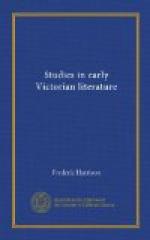Widely as these differ among themselves, they have characters which differentiate them from all men of the eighteenth century, and also from the men of the era of Goethe and Scott. Can we imagine Sartor Resartus being published in the age of Johnson, or In Memoriam in that of Byron? How different a land is the Italy which Ruskin sees from the Italy that Rogers knew! What a new world is that of the Brontes and George Eliot beside that which was painted by Miss Edgeworth and Miss Austen! In what things would Southey and John Morley agree, except about books and pure English? Place Burke On the Sublime and Beautiful beside Ruskin’s Modern Painters; compare the Stones of Venice with Eustace’s Classical Tour; compare Carlyle’s French Revolution with Gibbon’s Decline and Fall; compare the Book of Snobs with Addison’s Spectator; contrast The Ring and the Book with Gray’s Elegy or Cowper’s Task. What wholly different types, ideas, aims! The age of Pope and Addison, of Johnson and Gibbon, clung to symmetry, “the grand air,” the “best models”; it cared much more for books than for social reforms, and in the world of letters a classical manner was valued far more than originality of ideas. And when we come to a later age, what an irrepressible and stormy imagination do we find! Byron, Shelley, Scott, Coleridge, Campbell, Southey, Landor, revelled in romance and colour, in battle and phantasmagoria, in tragedy, mystery, and legend. They boiled over with excitement, and their visions were full of fight. The roar and fire of the great revolutionary struggle filled men’s brains with fierce and strange dreams.
Our Victorian Age is as different from the Virgilian and Ciceronian style of the age of Gray and Johnson, as it is from the resounding torrent which was poured forth by Byron and Scott. The social earnestness of our time colours our literature, and almost distorts our literature; while, on the other hand, our practical and scientific genius scorns the melodramatic imagery with which our grandfathers were delighted. Gibbon would have smiled a cruel epigram, if he had been expected to thrust a Latter-Day Pamphlet on the social question into one of his chapters on the Fall of Rome. But Carlyle’s French Revolution is as much political rhapsody and invective as it is




